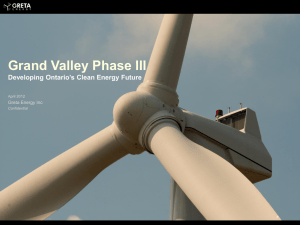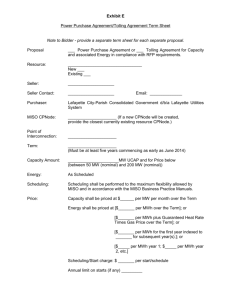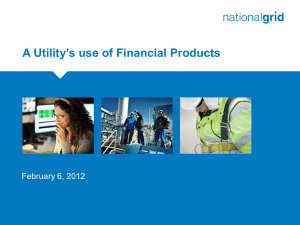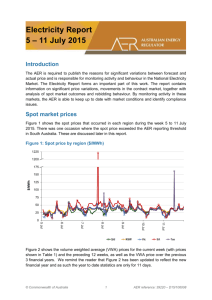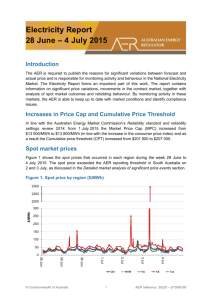21 to 27 July 2013 - Australian Energy Regulator
advertisement
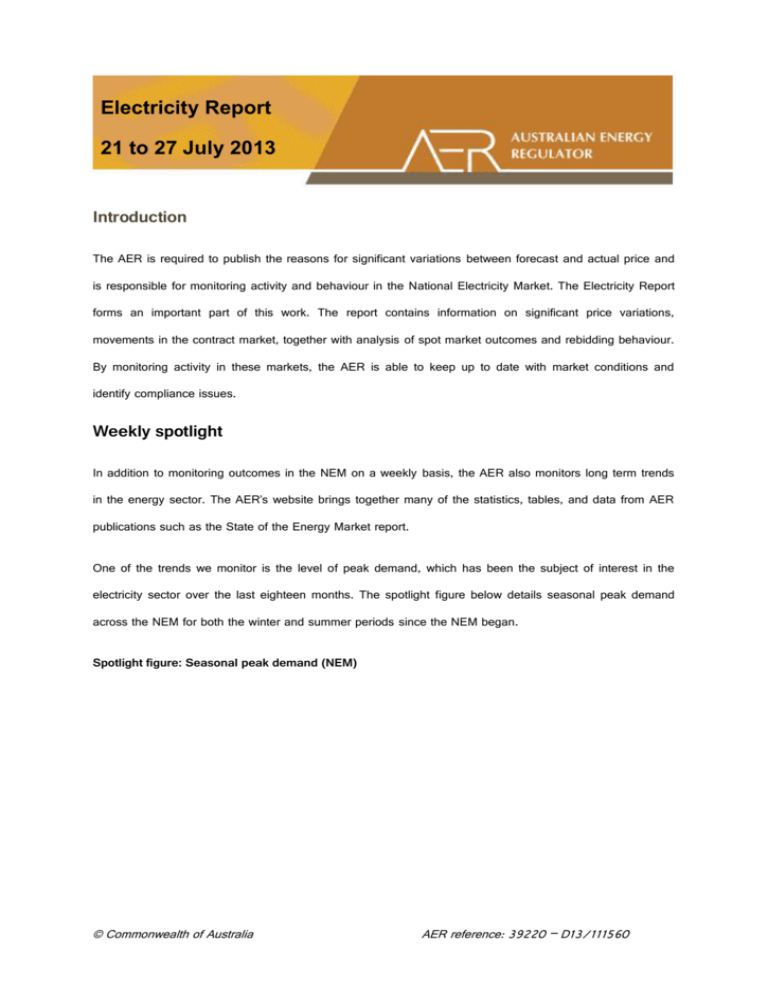
Electricity Report 21 to 27 July 2013 Introduction The AER is required to publish the reasons for significant variations between forecast and actual price and is responsible for monitoring activity and behaviour in the National Electricity Market. The Electricity Report forms an important part of this work. The report contains information on significant price variations, movements in the contract market, together with analysis of spot market outcomes and rebidding behaviour. By monitoring activity in these markets, the AER is able to keep up to date with market conditions and identify compliance issues. Weekly spotlight In addition to monitoring outcomes in the NEM on a weekly basis, the AER also monitors long term trends in the energy sector. The AER’s website brings together many of the statistics, tables, and data from AER publications such as the State of the Energy Market report. One of the trends we monitor is the level of peak demand, which has been the subject of interest in the electricity sector over the last eighteen months. The spotlight figure below details seasonal peak demand across the NEM for both the winter and summer periods since the NEM began. Spotlight figure: Seasonal peak demand (NEM) © Commonwealth of Australia AER reference: 39220 – D13/111560 40 Gigawatts 35 30 25 20 2013 (YTD) 2012/13 2012 2011/12 2011 2010/11 2010 2009/10 2009 2008/09 2008 2007/08 2007 2006/07 2006 2005/06 2005 2004/05 2004 2003/04 2003 2002/03 2002 2001/02 2001 2000/01 2000 1999/00 1999 1998/99 Summer Winter Note: Tasmania joined the NEM in May 2005. The figure shows a steady increase in peak demand for both winter and summer from 1998 up to around 2009. From 2009, peak demand remained steady before trending downwards in recent years. Winter peak demand in 2012, for example, was the lowest since 2004. More statistics can be found in the performance of the energy sector section of our website. Spot market prices Figure 1 shows the volume weighted average (VWA) prices for the current week (with prices shown in Table 1) and the preceding 12 weeks, as well as the VWA price over the previous 3 financial years. 2 Figure 1: Volume weighted average spot price by region ($/MWh) 250 $/MWh 200 150 100 50 0 Current week Tas Previous week 7 Jul 30 Jun SA 23 Jun 16 Jun Vic 9 Jun NSW 2 Jun 26 May 19 May 12 May 5 May 28 Apr 12/13 FY 11/12 FY 10/11 FY Qld Table 1: Volume weighted average spot prices by region ($/MWh) Region Qld NSW Vic SA Tas Current week 71 62 63 78 50 12-13 financial YTD 65 68 77 83 61 13-14 financial YTD 62 59 60 72 52 Longer-term statistics tracking average spot market prices are available on the AER website. Spot market price forecast variations The AER is required under the National Electricity Rules to determine whether there is a significant variation between the forecast spot price published by the Australian Energy Market Operator (AEMO) and the actual spot price and, if there is a variation, state why the AER considers the significant price variation occurred. It is not unusual for there to be significant variations as demand forecasts vary and participants react to changing market conditions. A key focus is whether the actual price differs significantly from the forecast price either four or 12 hours ahead. These timeframes have been chosen as indicative of the time frames within which different technology types may be able to commit (intermediate plant within four hours and slow start plant within 12 hours). There were 113 trading intervals throughout the week where actual prices varied significantly from forecasts. This compares to the weekly average in 2012 of 60 counts and the average in 2011 of 78. Reasons for the 3 variations for this week are summarised in Table 2. Based on AER analysis, the table summarises (as a percentage) the number of times when the actual price differs significantly from the forecast price four or 12 hours ahead and the major reason for that variation. The reasons are classified as availability (which means that there is a change in the total quantity or price offered for generation), demand forecast inaccuracy, changes to network capability or as a combination of factors (when there is not one dominant reason). An instance where both four and 12 hour ahead forecasts differ significantly from the actual price will be counted as two variations. Table 2: Reasons for variations between forecast and actual prices Reason for variation Availability Demand Network Combination % of total above forecast 2 6 0 2 % of total below forecast 22 45 0 23 Note: Due to rounding, the total may not be exactly 100 per cent Generation and bidding patterns The AER reviews generator bidding as part of its market monitoring to better understand the drivers behind price variations. Figures 2 to 6 show, the total generation dispatched and the amounts of capacity offered within certain price bands for each 30 minute trading interval in each region. 4 Figure 2: Queensland generation and bidding patterns 12000 10000 MW 8000 6000 4000 2000 0 12 noon - 27 Jul 5 12 noon - 26 Jul $0/MWh to $50/MWh $500/MWh to $5000/MWh 12 noon - 25 Jul 12 noon - 24 Jul 12 noon - 23 Jul 12 noon - 22 Jul 12 noon - 21 Jul <$0/MWh $100/MWh to $500/MWh Total generation (MW) $50/MWh to $100/MWh Above $5000/MWh Figure 3: New South Wales generation and bidding patterns 16000 14000 12000 MW 10000 8000 6000 4000 2000 0 12 noon - 27 Jul 6 12 noon - 26 Jul $0/MWh to $50/MWh $500/MWh to $5000/MWh 12 noon - 25 Jul 12 noon - 24 Jul 12 noon - 23 Jul 12 noon - 22 Jul 12 noon - 21 Jul <$0/MWh $100/MWh to $500/MWh Total generation (MW) $50/MWh to $100/MWh Above $5000/MWh Figure 4: Victoria generation and bidding patterns 12000 10000 MW 8000 6000 4000 2000 0 $50/MWh to $100/MWh Above $5000/MWh 12 noon - 27 Jul 7 12 noon - 26 Jul $0/MWh to $50/MWh $500/MWh to $5000/MWh 12 noon - 25 Jul 12 noon - 24 Jul 12 noon - 23 Jul 12 noon - 22 Jul 12 noon - 21 Jul <$0/MWh $100/MWh to $500/MWh Total generation (MW) Figure 5: South Australia generation and bidding patterns 3000 2500 MW 2000 1500 1000 500 0 12 noon - 27 Jul $0/MWh to $50/MWh $500/MWh to $5000/MWh 12 noon - 26 Jul 12 noon - 25 Jul 12 noon - 24 Jul 12 noon - 23 Jul 12 noon - 22 Jul 12 noon - 21 Jul <$0/MWh $100/MWh to $500/MWh Total generation (MW) $50/MWh to $100/MWh Above $5000/MWh Figure 6: Tasmania generation and bidding patterns 3000 2500 MW 2000 1500 1000 500 0 12 noon - 27 Jul 8 12 noon - 26 Jul $0/MWh to $50/MWh $500/MWh to $5000/MWh 12 noon - 25 Jul 12 noon - 24 Jul 12 noon - 23 Jul 12 noon - 22 Jul 12 noon - 21 Jul <$0/MWh $100/MWh to $500/MWh Total generation (MW) $50/MWh to $100/MWh Above $5000/MWh Frequency control ancillary services markets Frequency control ancillary services (FCAS) are required to maintain the frequency of the power system within the frequency operating standards. Raise and lower regulation services are used to address small fluctuations in frequency, while raise and lower contingency services are used to address larger frequency deviations. There are six contingency services: fast services, which arrest a frequency deviation within the first 6 seconds of a contingent event (raise and lower 6 second) slow services, which stabilise frequency deviations within 60 seconds of the event (raise and lower 60 second) delayed services, which return the frequency to the normal operating band within 5 minutes (raise and lower 5 minute) at which time the five minute dispatch process will take effect. The Electricity Rules stipulate that generators pay for raise contingency services and customers pay for lower contingency services. Regulation services are paid for on a “causer pays” basis determined every four weeks by AEMO. The total cost of FCAS on the mainland for the week was $276 000 or less than 1 per cent of energy turnover on the mainland. In Tasmania (which requires dedicated services for much of the time) the total cost for the week was $57 500 or less than one per cent of energy turnover in Tasmania. Figure 7 shows the daily breakdown of costs for each service, as well as the average daily costs for the previous financial year. 9 Figure 7: Daily frequency control ancillary service cost 80 000 60 000 $ 40 000 20 000 0 27 Jul Raise 5min Lower 5min 26 Jul 25 Jul Raise 60sec Lower 60sec 24 Jul 23 Jul 22 Jul 21 Jul Average cost Raise 6sec Lower 6sec Raise Reg Lower Reg Detailed market analysis of significant price events We provide more detailed analysis of events where the spot price was greater than three times the weekly average price in a region and above $250/MWh or was below -$100/MWh. There was one such occasion during this week, which occurred in Queensland on Wednesday 24 July. The table below shows the actual Queensland price, demand and available capacity outcomes compared to those forecast 4 and 12 hour ahead. Table 3: Queensland, Wednesday 24 July 6:30 AM Actual 4 hr forecast 12 hr forecast Price ($/MWh) 2243.81 56.12 66.21 Demand (MW) 5750 5680 5709 10 Available capacity (MW) 9601 9489 9659 Conditions at the time saw demand 70 MW and available capacity 112 MW greater than that forecast four hours ahead. At 6.08 am, effective at 6.10 am, CS Energy rebid 120 MW at Gladstone from prices below $55/MWh to above $12 700/MWh. The reason given was “Portfolio rearrangement due to-cb2 return–SL”. Over two rebids at 6.02 am and 6.17 am, effective from 6.10 am and 6.25 am respectively, CS Energy reduced the availability of Kogan Creek by a total of 138 MW. All of this capacity was priced below $40/MWh. This saw Kogan Creek output decreased from around 720 MW at 6.05 am to 587 MW at 6.25 am. The reasons given were “Testing –F/F out of service – SL” and “Technical issues –runback due to F/F issue – SL”. These rebids were only effective for the 6.30 am trading interval. At 6.30 am demand in Queensland increased by 164 MW (from 5828 MW at 6.25 am to 5992 MW at 6.30 am), while the export limit on QNI reduced by 78 MW into Queensland (from 330 MW to 258 MW). The reduction in limit occurred when a constraint used to manage voltage stability on the loss of Kogan Creek bound. Generators with low priced capacity were either ramp rate limited or limited by their fast start inflexibility profile, hence higher priced generation was dispatched, setting the price at $13 005/MWh at 6.30 am. By 6.35 am, with some generators no longer ramp rate limited and a step increase in low price capacity available at Kogan Creek, prices reduced to below $76/MWh. There was no other significant rebidding. 11 Financial markets Figure 8 shows for all mainland regions the prices for base contracts (and total traded quantities for the week) for each quarter for the next four financial years. 120 900 100 750 80 600 60 450 40 300 20 150 0 Number of contracts traded $/MWh Figure 8: Quarterly base future prices Q3 2013 – Q2 2017 0 Q2 2017 Q1 2017 Q4 2016 Vic volume Vic Q3 2016 Q2 2016 Q1 2016 NSW volume NSW Q4 2015 Q3 2015 Q2 2015 Q1 2015 Q4 2014 Q3 2014 Q2 2014 Q1 2014 Q4 2013 Q3 2013 Qld volume Qld SA volume SA Source: ASXEnergy.com.au Figure 9 shows how the price for each regional Quarter 1 2014 base contract has changed over the last 10 weeks (as well as the total number of trades each week). The closing Quarter 1 2012 and Quarter 1 2013 prices are also shown. 12 120 600 100 500 80 400 60 300 40 200 20 100 0 Number of contracts traded $/MWh Figure 9: Price of Q1 2014 base contracts over the past 10 weeks (and the past 2 years) 0 Current 14 Jul Vic volume Vic 07 Jul 30 Jun NSW volume NSW 23 Jun 16 Jun 09 Jun 02 Jun 26 May 19 May Q1 2013 Q1 2012 Qld volume Qld SA volume SA Note: Base contract prices are shown for each of the current week and the previous 9 weeks, with average prices shown for yearly periods 1 and 2 years prior to the current year Source: ASXEnergy.com.au Prices of other financial products (including longer-term price trends) are available in the Performance of the Energy Sector section of our website. Figure 10 shows how the price for each regional Quarter 1 2014 cap contract has changed over the last 10 weeks (as well as the total number of trades each week). The closing Quarter 1 2012 and Quarter 1 2013 prices are also shown. The cap contracts limit exposure to extreme spot prices (above $300/MWh) and is an indicator of the cost of risk management. 13 25 150 20 120 15 90 10 60 5 30 0 0 14 SA volume SA Current August 2013 14 Jul Australian Energy Regulator Vic volume Vic 07 Jul Source: ASXEnergy.com.au 30 Jun NSW volume NSW 23 Jun 16 Jun 09 Jun 02 Jun 26 May 19 May Q1 2013 Q1 2012 Qld volume Qld Number of contracts traded $/MWh Figure 10: Price of Q1 2014 cap contracts over the past 10 weeks (and the past 2 years)
